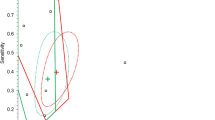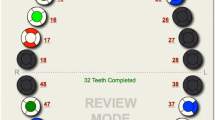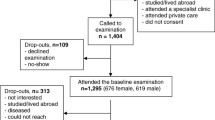Abstract
The objective of this study was to verify how valid misclassification measurements obtained from a ‘pre-survey’ calibration exercise are by comparing them to validation scores obtained in ‘field’ conditions. Validation data were collected from the ‘Smile for Life’ project, an oral health intervention study in Flemish children. A calibration exercise was organized under ‘pre-survey’ conditions (32 age-matched children examined by eight examiners and the benchmark scorer). In addition, using a pre-determined sampling scheme blinded to the examiners, the benchmark scorer re-examined between six and 11 children screened by each of the dentists during the survey. Factors influencing sensitivity and specificity for scoring caries experience (CE) were investigated, including examiner, tooth type, surface type, tooth position (upper/lower jaw, right/left side) and validation setting (pre-survey versus field). In order to account for the clustering effect in the data, a generalized estimating equations approach was applied. Sensitivity scores were influenced not only by the calibration setting (lower sensitivity in field conditions, p < 0.01), but also by examiner, tooth type (lower sensitivity in molar teeth, p < 0.01) and tooth position (lower sensitivity in the lower jaw, p < 0.01). Factors influencing specificity were examiner, tooth type (lower specificity in molar teeth, p < 0.01) and surface type (the occlusal surface with a lower specificity than other surfaces) but not the validation setting. Misclassification measurements for scoring CE are influenced by several factors. In this study, the validation setting influenced sensitivity, with lower scores obtained when measuring data validity in ‘field’ conditions. Results obtained in a pre-survey calibration setting need to be interpreted with caution and do not (always) reflect the actual performance of examiners during the field work.
Similar content being viewed by others
References
International Caries Detection and Assessment System Coordinating Committee (2009) Criteria manual—international caries detection and assessment system (ICDAS II)
Pitts NB, Evans DJ, Pine CM (1997) British Association for the Study of Community Dentistry (BASCD) diagnostic criteria for caries prevalence surveys-1996/97. Community Dent Health 14(Suppl 1):6–9
World Health Organization (1997) Oral health surveys. Basic methods. World Health Organization, Geneva
Assaf AV, Tagliaferro EP, Meneghim MC, Tengan C, Pereira AC, Ambrosano GM, Mialhe FL (2007) A new approach for interexaminer reliability data analysis on dental caries calibration. J Appl Oral Sci 15:480–485
Mwalili SM, Lesaffre E, Declerck D (2008) The zero-inflated negative binomial regression model with correction for misclassification: an example in caries research. Stat Meth Med Res 17:123–139
Mutsvari T, Lesaffre E, Garcia-Zattera MJ, Diya L, Declerck D (2010) Factors that influence data quality in caries experience detection: a multilevel modeling approach. Caries Res 44:438–444
Declerck D, Leroy R, Martens L, Lesaffre E, Garcia-Zattera MJ, Vanden BS, Debyser M, Hoppenbrouwers K (2008) Factors associated with prevalence and severity of caries experience in preschool children. Community Dent Oral Epidemiol 36:168–178
Pine CM, Pitts NB, Nugent ZJ (1997) British Association for the Study of Community Dentistry (BASCD) guidance on the statistical aspects of training and calibration of examiners for surveys of child dental health. A BASCD coordinated dental epidemiology programme quality standard 2. Community Dent Health 14(Suppl 1):18–29
William FM, Nan G (2006) Estimation of sensitivity and specificity of clustered binary data. Statistics and data analysis, SUGI 31 proceedings, SAS Proceedings
Liang KY, Zeger SL (1986) Longitudinal data analysis using generalized linear models. Biometrika 73:13–22
Gorelick MH, Atabaki SM, Hoyle J, Dayan PS, Holmes JF, Holubkov R, Monroe D, Callahan JM, Kuppermann N (2008) Interobserver agreement in assessment of clinical variables in children with blunt head trauma. Acad Emerg Med 15:812–818
Helderman WH, Mulder J, van’T Hof MA, Truin GJ (2001) Validation of a Swiss method of caries prediction in Dutch children. Community Dent Oral Epidemiol 29:341–345
Castiglia P, Campus G, Solinas G, Maida C, Strohmenger L (2007) Children's oral health in Italy: training and clinical calibration of examiners for the National Pathfinder about caries disease. Oral Health Prev Dent 5:255–261
Cleaton-Jones P, Hargreaves JA, Fatti LP, Chandler HD, Grossman ES (1989) Dental caries diagnosis calibration for clinical field surveys. Caries Res 23:195–199
Agbaje JO, Mutsvari T, Lesaffre E, Declerck D (2010) Measurement, analysis and interpretation of examiner reliability in caries experience surveys: some methodological thoughts. Clin Oral Investig (in press)
Lesaffre E, Mwalili SM, Declerck D (2004) Analysis of caries experience taking inter-observer bias and variability into account. J Dent Res 83:951–955
Williamson JM, Lipsitz SR, Manatunga AK (2000) Modeling kappa for measuring dependent categorical agreement data. Biostatistics 1:191–202
Heifetz SB, Brunelle JA, Horowitz HS, Leske GS (1985) Examiner consistency and group balance at baseline of a caries clinical trial. Community Dent Oral Epidemiol 13:82–85
Poorterman JH, Verheij JG, Kieft JA, Eijkman MA (1997) Variations among dentists in the diagnosis of caries and assessment of dental restorations. Ned Tijdschr Tandheelkd 104:214–218
Cortes DF, Ellwood RP, Ekstrand KR (2003) An in vitro comparison of a combined FOTI/visual examination of occlusal caries with other caries diagnostic methods and the effect of stain on their diagnostic performance. Caries Res 37:8–16
Mojon P, Favre P, Chung JP, Budtz-Jorgensen E (1995) Examiner agreement on caries detection and plaque accumulation during dental surveys of elders. Gerodontology 12:49–55
Acknowledgements
This investigation was supported by Research Grant OT/05/60, Catholic University Leuven. The following partners collaborated in the “Smile for Life Project”: Dominique Declerck (Project Coordinator) and Roos Leroy (both from the Department of Dentistry, Catholic University Leuven), Karel Hoppenbrouwers (Youth Health Care at the Catholic University Leuven, and the Flemish Society for Youth Health Care), Emmanuel Lesaffre (Centre for Biostatistics, Catholic University Leuven), Stephan Vanden Broucke (Research Group for Stress, Health and Well-being at the Catholic University Leuven), Luc Martens (Dental School, Ghent University), Erwin Van Kerschaver and Martine Debyser (Child and Family). The study was supported financially by GABA Benelux and GABA International.
Conflict of interests
The authors declare that they have no conflict of interests.
Author information
Authors and Affiliations
Corresponding author
Appendix
Appendix
Logistic regression model for sensitivity and specificity
Suppose that the binary score for CE is denoted as Y for the benchmark and Y* is the score attributed by the examiner. Thus, Y = 1 corresponds to CE truly present, and Y = 0 means no CE present. Using this notation, sensitivity is equal to \( {\pi_{\rm{se}}} = { \Pr }\left( {Y* = {1}|Y = {1}} \right) \) and specificity is equal to \( {\pi_{\rm{sp}}} = { \Pr }\left( {Y* = 0|Y = 0} \right) \).
A logistic regression model relating π se and π sp to p factors x 1, x 2,…x p is given by:
respectively, where logit \( \left( \pi \right) = { \log }\left( {\pi /\left[ {{1}-\pi } \right]} \right) \). The coefficients β 0, β 1,…, β p and γ 0, γ 1,…, γ p are called regression coefficients and are estimated according to the method of maximum likelihood. The coefficients β 0 and γ 0 are called intercepts. The other coefficients measure the strength of the relationship between the regressors and sensitivity and specificity, respectively.
Models 1 and 2 assume that the data are independent. However, here, the data are clustered, since surfaces are nested within teeth, and teeth are nested within mouths. Therefore, the models were extended further to account for this clustering using the GEE approach. This approach is based on supposing at the start a correlation structure for the outcomes, called working correlation matrix. The term ‘working’ refers to the fact that it is good enough that the correlation matrix roughly represents the true correlation structure. Here, an exchangeable working correlation was assumed, which means that the correlation of CE among surfaces on the same tooth and on teeth in the same mouth are all equal.
Rights and permissions
About this article
Cite this article
Agbaje, J.O., Mutsvari, T., Lesaffre, E. et al. Examiner performance in calibration exercises compared with field conditions when scoring caries experience. Clin Oral Invest 16, 481–488 (2012). https://doi.org/10.1007/s00784-011-0523-1
Received:
Accepted:
Published:
Issue Date:
DOI: https://doi.org/10.1007/s00784-011-0523-1




